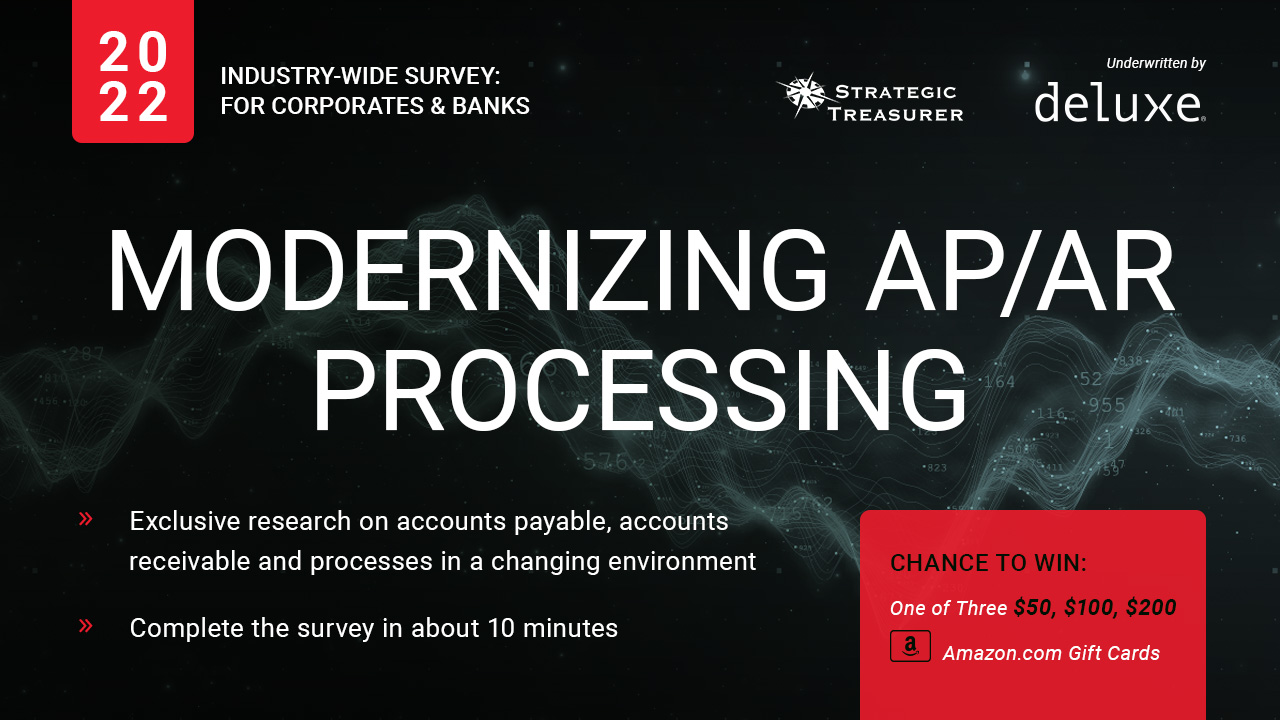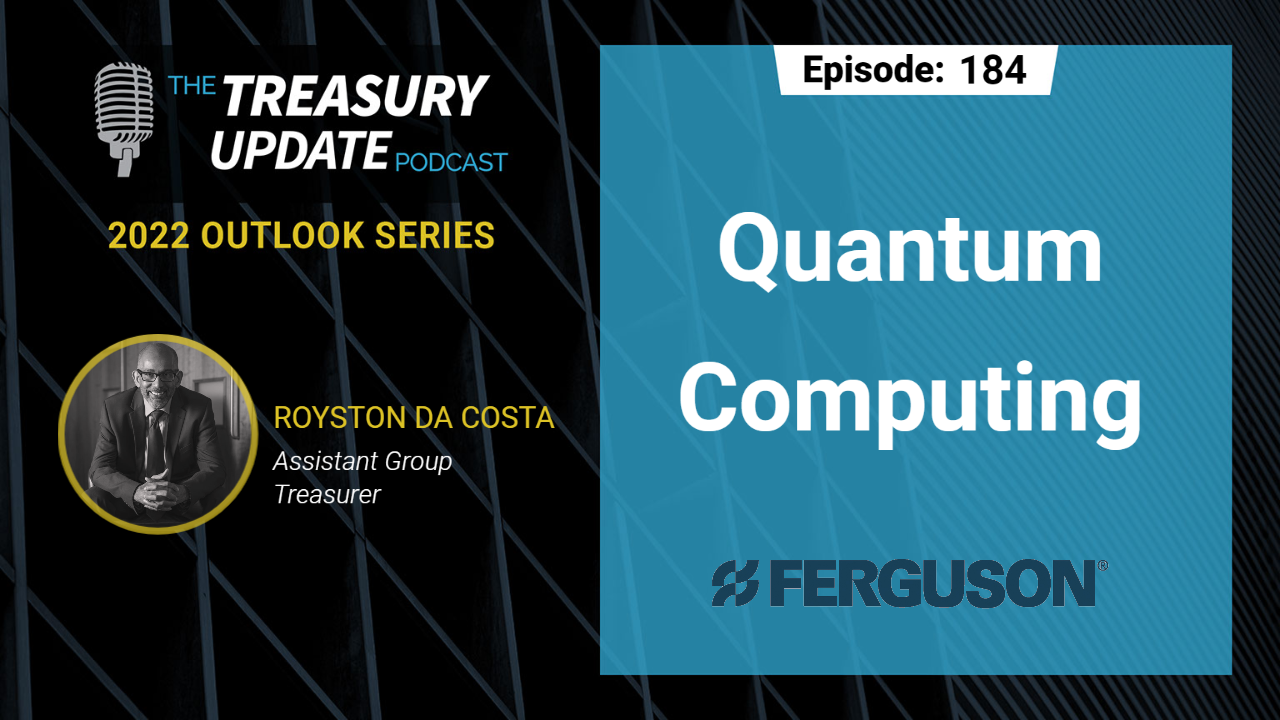
Episode 195
Key Data Points of Fraud, Technology, and Payments
In this episode, Nicki Gillispie and Craig Jeffery of Strategic Treasurer discuss fraud, technology, and payments. What are some of the most recent key data points and items of interest that treasury should know? Listen in to find out more.
Download the report here: strategictreasurer.com/fraud
Speaker:
Craig Jeffery, Strategic Treasurer


Episode Transcription - Episode #195: Key Data Points of Fraud, Technology, and Payments
Nicki Gillispie 00:04
Welcome to the Treasury Update Podcast presented by Strategic Treasure, your source for interesting treasury news, analysis, and insights in your car, at the gym or wherever you decide to tune it. Strategic Treasurer does extensive market research and is involved in fintechs, banks, and corporations. Craig Jeffery is the head of research at Strategic Treasure. We have three areas to discuss today: fraud, technology, and payments. What are some of the key data points or items of interest that treasury and payment professionals should know? Let’s start with the seriousness of fraud escalation.
Craig Jeffery 00:41
Yeah, thanks, Nicki. I have two points here on this topic. We talked about the seriousness of fraud and how that’s escalated how people see it is increasingly serious. But there’s there’s two things, two data points, I think everyone should know about. One, the US government has issued warnings and requirements for certain industries, to report on ransomware, either ransomware attack or ransomware payment, and there’s very tight timeframes for this. Now, this is a significant shift in what the government’s requiring. And this requirement comes concurrently or about the same time as Russia’s attack and invasion of Ukraine and threats of different types of cyber warfare, cyber attacks. So this is a very serious warning. It’s intended for mission critical institutions and industries. There’s a list that’s available for that. And so that’s that’s the first point government warnings. The second is the Treasury Fraud and Control Survey that was just released. This is done in conjunction with Bottomline Technology. The survey results of this showed that the threat of fraud has significantly increased. Those indicating that they saw this threat significantly increased, has reached 29%. This year, 29% say that the threat has significantly increased from the prior year. That’s pretty useful by itself. But this is a survey that we’ve run for seven years. If we go back four years, those that indicated this threat of significant increase was 16%. We go back three years it was 20 and 25. And now 29%. So this 16, 20, 25, and almost 30% on a year over year basis is certainly significant. And can be, I think it should be concerning because your peers are now recognizing this threat level has significantly increased to basically three out of 10. In the shownotes, we’ll go ahead and place information about downloading the report, which includes this data. So that’s a free report, you can get that at strategictreasure.com, the Treasury Fraud and Control report for 2022.
Nicki Gillispie 02:54
And why do you think that’s so important?
Craig Jeffery 02:57
Anytime someone talks about fraud, cyber fraud, there’s this view that we have to be scary about it to get people to act. And this has gone on for quite a few years, many, many years now, you know more than seven where people have been concerned about fraud and are talking about. But the fear is based on reality. This is not some horror show. But it’s an it’s not just fun to talk about. It’s real, the losses are very significant. If you look at ransomware, the losses used to be $10,000, they exceeded $100,000. Now, some reports are showing that its entities, it’s costing them over half a million between paying off ransom and recovering their systems and sites. So it’s real. And it’s not just fun to talk about. And I think it matters because we is as finance professionals, IT professionals, security professionals, stewards of corporate data and corporate funds, we need to respond to this ongoing increased threat with a journey mindset, not a destination like oh, we’ve arrived, nothing else needs to be done. But we need to think about this as we need to respond on an ongoing basis, not like treating it like it was an event. To do this, we need we need better training and better tools. And I’ll leave it there. Those are the those are some of the things why it matters. It’s real. We need to respond that as part of the journey. And we need better training for the human element. We need better tools for the technical environment.
Nicki Gillispie 04:31
Great, thank you. Let’s move on to technology. Can we cover some key points on technology?
Craig Jeffery 04:36
There’s a couple of things I want to talk about here on technology. Two main points. One is the adoption rates for machine learning and the adoption rates for the use of API’s or application programming interface. And if you’ve been listening to the podcasts, you’ve probably heard this a couple of times before so but when we look at how companies are adopting technology or what they plan to do, there’s is over optimistic attitude that we’re going to implement more technology, we’re going to make these changes in this period of time. It’s a bit overzealous. And so when we really see how people adopt technology, and the plans, it tends to come in the range of 65 to 75%. So if 15% expect to adopt something that might be, you know, 10, or 11, or 12%, actually adopted, it’s discounted by, you know, let’s say about 30%. That’s what’s typical, across different types of technologies, practices, etc. So that’s what we normally see. But with machine learning, and APIs, what we’re finding is the actual adoption is exceeding what the expectations were. So instead of discounting, it has to be added on top of so this is mostly over a one year period or a two year period. So we’re gathering information on what’s what’s occurring. And so that’s exceeding, so adoption rates for ML and APIs or machine learning APIs are going faster than expected. Two, the reality of API libraries. And this is not really from our research, but really from the work that we do. You know, the idea of, we wanted to expand the use of APIs and the fact that companies are adopting more APIs, or they’re at least adopting some APIs through some of their service providers. This above line growth, if you will, is happening, but it will take time. And part of that is API libraries that are being built out by tech firms, by banks, it takes time for them to build them out. They have a list of items, many, many items that they need to build these API libraries for, and it’s taking them it takes them time to build them all out. And so everyone can commit to an API first world. But the reality is, some banks are really early in their journey. Maybe they’re not, they’re not even birthed yet, and very few are in a very mature state. But many are developing quickly. So I think it’s there’s growth. But this is going to take time for a maturity of the infrastructure, maturity of these libraries to be complete.
Nicki Gillispie 07:11
Why do you think this matters?
Craig Jeffery 07:12
The implication here is that because adoption is faster than expected, we can have an over zealous attitude for what will occur going forward in terms of penetration of how many connections we have how we’re sharing information, having several API’s up or connecting to a banker to some API’s, or some other data provider doesn’t mean all of your connections are going to be replaced, all of your SFTP connections are replaced with API’s right away. So I think there’s one aspect here that we need to think that the transition is going to take longer than expected. And that doesn’t mean pause the journey. Second, banks and technology firms may see some massive gapping occurring. And what I mean by that is, those that are pushing their API libraries or their app libraries, are going to do better than those who are taking a wait and see approach. So I think this gapping, there are some that are much further along in their journey than other banks, for instance. And this is scaling rapidly as we see the adoption pickup, that’s going to increase the efficiency that some companies are experiencing with their banks, lower levels of of issues, faster adoption, just easier to do business, this whole mindset of less friction matters significantly to firms that are using systems dealing with their banks, and those that aren’t, they’re going to that gap is going to widen. And that should be concerning for both those that are slow on the journey, or those that are playing a wait and see attitude.
Nicki Gillispie 08:43
Let’s look at payments. And specifically let’s look at pain in the payments process. What are the pains of payments and what really matters?
Craig Jeffery 08:51
Payments is a huge area for finance, both for AP for Treasury, you know, even for accounts receivable, there’s a payment coming in on on that side of the equation. And from a bank perspective, this is a huge area of revenue from payment companies, you know, some of the card companies, other entities that are focused on payments. This is a huge area of focus. It’s an area of growth, growth and revenue growth and opportunity. So there’s a lot of attention paid here, but what what are the pains in payments? And what are the implications of that. So the biggest problem with payments, when we look at payments and they look at the whole space, the biggest identified problems are forecasting and exception management and what comes in third is efficiency. So those are viewed as the biggest problems in the payment process. Challenges include IT resourcing. This is a significant area why people can’t move or have a hard time moving. And that tends to outstrip issues with management priorities. So we can see, efficiency isn’t a key driver there. That’s the fifth point of our six points in these three sections. The next one is, you know, what makes people move what makes people move payment providers or service providers, whether it’s their bank or someone else. The top one, there is efficiency, while it was third in terms of the pain point, it was top in terms of making people move efficiency. But that’s not all. There is significant data that shows that providers and we’ll think about banks first here, providers who are not keeping up with newer payment types, newer payment services that help with compliance, control, validation, those providers that are not keeping up with the new payment types, are very susceptible to having that part of the business move. Even if they’re providing credit. There’s a significant minority of companies who are willing to move their payment business to another, say bank in their credit facility. But there’s not quite as high but still a significant minority of companies who would move to a provider outside of the bank group. So someone not providing them credit. That’s some of the background for the pain of payment. And, and part of why it matters. I know there’s there’s more there.
Nicki Gillispie 11:10
So with the payment pains, why focus on these? Why are they important?
Craig Jeffery 11:15
From a company standpoint, that’s that’s doing business with payment providers, moving payment providers, is extremely hard. Why is it hard? Why is it extremely hard? Well, they have a lot of things going on. And it requires I’ve got to involve operations I’ve got I have to involve IT to make a movement. And so there has to be something significant to make a movement, the current lack of inertia means you’re not not necessarily going to want to want to move, but it is getting significantly easier to move. And it will become far easier to move providers over time, with easier connections, different ways of making, you know, our connections to payment providers, executing transfers, they’ll become less friction over time. And I you know, to your question, payment providers and banks, need to understand why people will move. You’re the current provider, you have a significant advantage there. But why will people move? And I think another question is why they can’t move? Or why are they not always able to move when they want to needs to be understood, just because people aren’t moving doesn’t mean they would, that they wouldn’t if they could, they certainly would. But there’s some problems, knowing that a sizable minority will move business, other banks and non banks should be top of mind. And I think one piece here to think about, or one point is that this additional willingness to move will become easier. And because it becomes easier, it will happen more rapidly. What are some of those challenges? People have problems with forecasting, exception management, efficiency, but also IT resourcing why don’t they move, they don’t have as much resources. There might be other management directors, but number one has to do with IT resourcing, and as we lift IT resourcing out of the issue or out of the mix, then movement will happen more rapidly. And this is similar to what happened with moving systems to the cloud. You know, first there was a lot of resistance from IT, we want to have our servers for production, for testing, we need to do it inside, we’re the only ones who can protect the data, there was a significant resistance by IT, they ran the process. And what’s happened over the last decade is that’s moved from, we want to have our data and our processes stored in the cloud and run in the cloud. And because that’s the case, that’s become the new method, you know, IT I think has realized there is so much to do, they need the scalability, they’re not going to be out of work. They’re gonna have a ton, a ton to do and the development, the speed, and the ability to service is supported by some of these other tools. And that’s making its way into the payment, the payment domain as well. So, those are some of the reasons why, why it matters.
Announcer 14:07
You’ve reached the end of another episode of the Treasury Update Podcast. Be sure to follow Strategic Treasure on LinkedIn. Just search for Strategic Treasure. This podcast is provided for informational purposes only, and statements made by Strategic Treasure LLC on this podcast are not intended as legal, business, consulting, or tax advice. For more information, visit and bookmark StrategicTreasure.com.
Subscribe to the Treasury Update Podcast on your favorite app!
Related Resources
This survey, underwritten by Deluxe, looks at various practices and plans for modernizing and automating AP and AR processes. The influence of recent disruptions, calibration of various pain points that drive change, and other motivators to upgrade AP and AR processes will be examined.
On this episode of the 2022 Outlook series, Host Craig Jeffery joins Royston Da Costa, Assistant Group Treasurer at Ferguson plc, to discuss the outlook of quantum computing. They explore this developing technology, discuss how it’s relevant to finance and treasury, reveal which companies are using it now and its impact on cybersecurity.








